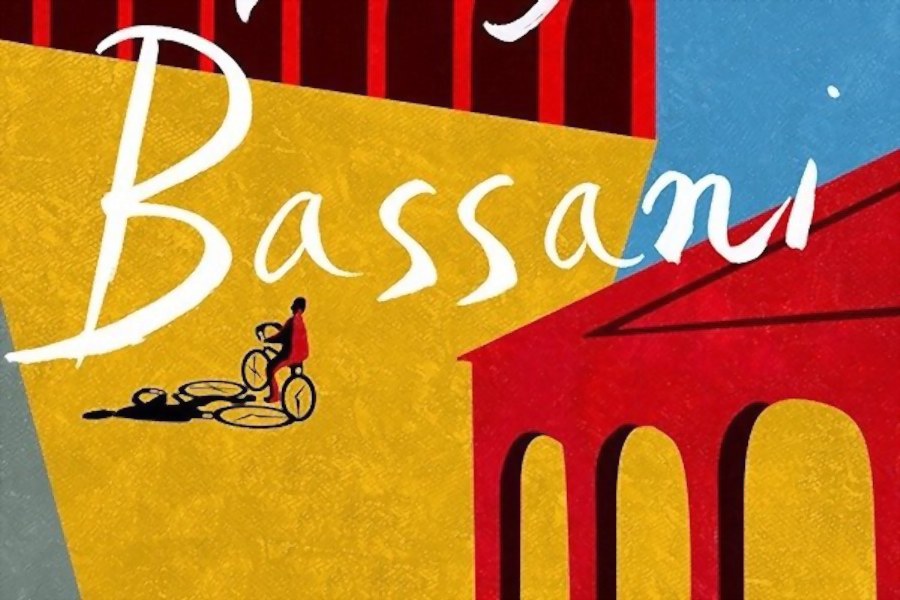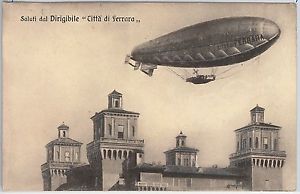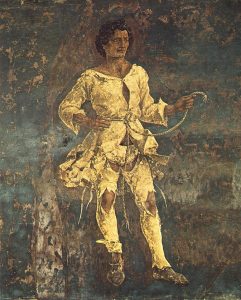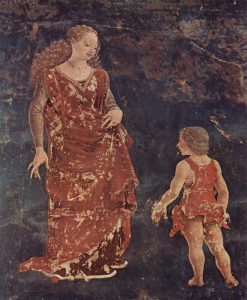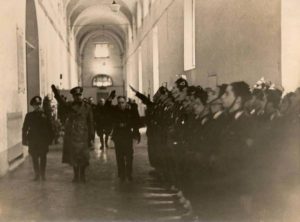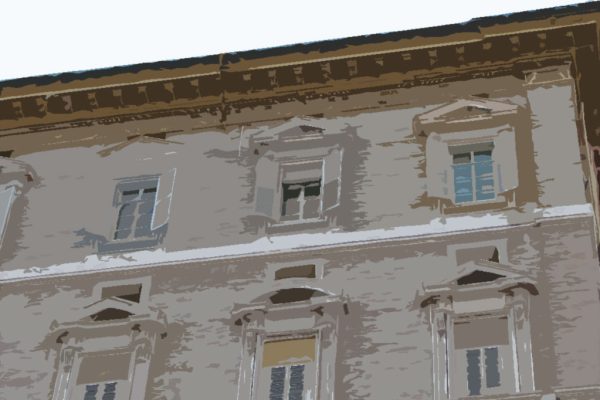The work of relatively few Italian novelists from the 20th Century has so far been translated more than once, but only Giorgio Bassani’s —in part or in its entirety— has been translated three times into English. A fact that attests to the interest and critical reception for his stories and novels, as well as to the complexity of his style. While I feel that the previous translations by Isabel Quigly and by William Weaver transformed Bassani’s prose into a standard English syntax and into a conventional novelistic narrative rhythm, the new translation by Jamie McKendrick (The Novel of Ferrara, New York W. W. Norton, 2018), achieves something new and remarkable. This translator chose a different path altogether: he has found a way to render Bassani’s notoriously complex syntax, his long, languorous sentences with many dependent clauses, and his almost musical rhythm — where ritardandos and diminuendos rule— into carefully wrought yet beautifully flowing English. Never before has reading Bassani in English resembled so closely the experience of reading him in the original.
Eighty years after Mussolini’s Racial Laws, as neo-Fascist and right-wing populism is on the rise in much of Europe, re-reading Bassani seems topical and timely. Few literary works have explored and anticipated, with such subtle sophistication the complexities of collective memory, and of the commemoration of the Shoah. And few have outlined as clearly how a critical stance toward the past becomes essential in understanding Italy’s post-war society up to this day.
At a time when American publishers are at minimum cautious with fiction in translation, one must admire the courage and foresight of W.W.Norton, who only three years after publishing Primo Levi’s Complete Works, has now published Bassani’s The Novel of Ferrara all in one handsome hardcover volume.
We met with the translator, Jamie McKendrick:
Alessandro Cassin: Literary translations require not only command of the language you are translating from, but also a real feel for the culture and the places of provenance of the work. Can you describe when and how your relationship with Italy and Italian developed?
Jamie McKendrick: Though my interest in Italian culture goes a long way back and was fortified by a university course on Renaissance art and architecture, and by visits to Rome and Florence when I was young, my interest in Italian literature was initially via translation – Dante, Montale, Ungaretti, Primo Levi, Sciascia, Buzzati and so on – until in my late twenties I taught at Salerno University as a lettore for four years. I arrived without any Italian and only a smattering of Latin and French to help, but I gradually found my feet in the language. The mezzogiorno is evidently a different Italy to Bassani’s – though one of his stories is set in Naples – but the four years I spent there gave me the opportunity to travel around extensively and to learn more about the place and feel more at home there. Still, I’d have to admit that in translating Bassani I had a great deal more to learn about the history, the culture and the language as well – an unforeseen bonus of the whole undertaking.
A.C.: The vast majority of Bassani’s work, certainly his prose, is based on recollections and recreations of the Ferrara he grew up in. Have you visited the city he so powerfully evokes in the Romanzo di Ferrara?
J.MC: I only visited Ferrara after I’d translated The Garden of the Finzi-Continis and The Gold-Rimmed Spectacles – the two novels I began with. Though Bassani has such an ingrained and precise sense of the city’s topography as well as its history, you can follow his characters’ wanderings street by street and have a good idea of the place even without visiting. Still, when I decided to translate the other books I felt I needed to know the city better and so have spent some time there, have got to walk down the streets I had pictured in my imagination – Via Mazzini, Corso Giovecca, Corso Ercole 1 d’Este etc. – and have cycled, as Bassani so frequently did, along the walls that entirely surround the city.
A.C.: Your commitment in time and thought in translating this monumental work must have been considerable. When did you first read Bassani and what compelled you to translate his work?
J.MK: Before I knew any Italian, I read Bassani’s The Gold-Rimmed Spectacles in Isabel Quigly’s translation, and thought it a masterpiece. Much later, I read that and The Garden in Italian which more than confirmed my admiration for him. It was my suggestion that Penguin republish Quigly’s translation that coincided fortuitously with the editor Adam Freudenheim’s intent to have Bassani retranslated, and so I agreed to translate these two novels. Later, with Norton also interested in the US, I was commissioned to translate the entire Romanzo.
A.C.: Bassani’s decades-long efforts in rewriting and editing his fiction are quite unique among Italian prose writers of the 20th Century, offering a real insight into both his creative process and critical sense. Is your translation based on the Italian edition in I Meridiani?
J.MC: Yes. It was agreed from the start by the publisher and the estate that the translation should be from the Mondadori I Meridiani edition of Opere, first published in 1998, which includes all of Bassani’s final revisions as well as some extra material he had added to the collection The Smell of Hay. After so many years turning back and forth and propping it open on my desk, its pristine pages have taken on a greyish hue and the spine has detached itself. I’ve been meaning to glue it back together as I can’t bear the thought of acquiring another copy.
I haven’t undertaken a systematic comparison between the original and revised texts, but for the most part – there are a couple of exceptions I’ll mention later – Bassani, it seems to me, has done a superb editorial job in this Herculean labour to harmonise the entire work. Apart from these revisions, the addition of an extra story and the concluding essay give a further rationale for the re-translation.
A.C.: I appreciate your introduction, however, I feel the lack of a critical apparatus to a work as philologically complex as the combining of six previously self-standing works into one. Further, I feel context and background could have been precious to an English speaking reader. I realize that the editor and publisher make these decisions, however, since I cannot imagine there will be a further edition any time soon it seems a bit of a lost occasion. Your thoughts?
J.MK: This is a fair question and one to which I’ve given a lot of thought – so much in fact that I now find it hard to answer it straightforwardly, and without getting embroiled again in the discussions and arguments I’ve had during the whole process. Suffice it to say, I was able to supply introductions to the first two Penguin translations (The Garden and The Gold-Rimmed Spectacles) then for the next one, The Smell of Hay, the novelist Ali Smith supplied an excellent introduction. Thereafter, for the final three books, there was no introduction at all, reflecting a change of policy in the publishing house. I feel that this was a mistake, and said so, particularly in the instance of Within the Walls where there’s such a welter of specific local, historical and political detail that having at least some apparatus to help the interested reader could have been a great bonus. I did my best by arguing vigorously for footnotes, another feature contemporary publishing is inclined to frown on. The Penguin omnibus edition has no foreword or introduction. The Norton has both. My view is that I’m happier with the latter.
As to whether the lack of more context and background has been a ‘missed opportunity’, I see exactly your point. But I’m in two minds. I think that a longer introduction might have offered more historical and social context (which, however, I did at least try to suggest in what I wrote) as well as a scholarly and literary critical account of Bassani’s writing, of its slow evolution and prolonged redrafting, but two things are against it for me. One is the length of the book, already an unwieldy 850 or so pages. Another is that Bassani himself provided an intriguing and authoritative account of that process in the final essay he appended to the volume, his autodescriptive ‘Down There, at the End of the Corridor’.
I was keen to write an introduction, and prompted by the editor Alane Mason at Norton, did include what I judged to be essential historical and urban detail, and still feel that to have gone much further would have been to intrude on the reader unnecessarily. The volume then would have become far more an academic text, but this was not the kind of book they, nor I for that matter, had in mind for the Romanzo.
A.C.: Having translated first his six individually prose works and now the same works as a whole monumental Romanzo di Ferrara can you address some of the small and large changes and revisions that took place?
And most importantly how did he create a structure so as to allow the reader to experience these works as part of a coherent whole?
J.MK: As I hinted before, I feel unqualified to comment on his overall revisions having never undertaken an extensive comparison. I have, however, made a number of local comparisons and my impression is that, apart from minor adjustments for consistency across the six books, much of the revision has been in the direction of clarity and concision. Just occasionally in my view that has resulted in a loss, a painful sacrifice. I can illustrate this with two examples.
The first I translated and included as an endnote for the Penguin edition of The Garden of the Finzi-Continis, concerns Micòl’s discourse on the trees in the garden which has, to my mind, been unfortunately curtailed. It’s such a beautiful paragraph that has been excised that I would love to have surreptitiously re-introduced it.
The second occurs at the end of Behind the Door, merely a sentence. I became aware of it when giving a talk on Bassani in London with Valerio Magrelli, who had the original text with him and drew attention to this strange comparison of the sand under the sea to the ribbing of the palette. Very much a poet’s simile – not at all showy but strikingly mysterious. At the very moment when the narrator has decided not to speak, to withhold his words, it strikes me as brilliantly suggestive to describe the interior of a mouth. There may be other such examples, of which I’m unaware, but in nearly all of the passages I’ve looked at I consider Bassani’s revisions to be improvements.
A.C.: The overall impression of your translation is that you successfully attempt to find a way to keep close to the original syntax, and breath of his prose. You maintain his long, meandering, languorous, ironical sentences. And the frequent parenthetic phrases that so deliberately slow down the narrative flow. Could you address some of the specific difficulties you encountered translating Bassani?
It seems to me that Bassani deliberately slows down the narrative as if to slow down historical time before the tragedy of the Shoah and the disappearance of the world of Ferrara’s Jewish community. This “slowness” and intricate syntax, also brings attention to the difficult act of remembering and the complex nature of memory in general. Can you comment?
J.MK: Bassani’s long sentences, full of parentheses and sub-clauses, are a characteristic of his prose from the outset as we can see already in Within the Walls. Even though English, especially contemporary English, is less favourably disposed to this feature, I was determined wherever possible to keep close to the rhythm and tempo that he established, and I’m gratified you think it works. Some readers (on the internet) have felt exasperated by these serpentine constructions, but I’ve noticed, with some relief, that their Italian counterparts make the same complaints about the original. It’s something you have to take or leave with Bassani. I’m very much in favour of it, and rarely found a sentence in the original whose complications weren’t ‘earned’ or functional.
The style is of the essence of Bassani’s work – sure, it reflects his cast of mind but it also registers the often arduous processes of memory at work, of his scrupulous attempt to render a past that is both in danger of vanishing and of being simplified in its representation. As you say, this rendering has to be responsive to the cross-play of irony, but it also includes a plethora of moods including the lyrical and the hesitant.
I’m in agreement with your final point and argue something similar in the introduction, comparing these long sentences to the games of tennis continuing beyond the dusk when the ball becomes all but invisible yet the play continues regardless. There is indeed, especially in The Garden of the Finzi-Continis and The Gold-Rimmed Spectacles, a sense that the extended sentences are trying to hold at bay the imminent disaster that hangs over his community and perhaps also to keep hold of the idyllic sensations of youth.
A.C.: Are there solutions or passages that you are particularly proud of?
J.MK: Conrad’s advice to writers was to score out any ‘purple passages’ so I suppose I shouldn’t really offer up any candidates. I take heart from Bassani’s account in that final essay of how slow he was in writing, in getting down to writing, in needing to continually rewrite and revise. Si parva licet…I very much share this mode. My first drafts are a mess with just the occasional small triumph, so I have to work and rework pretty well everything.
In The Garden there are passages of extraordinary depth and beauty such as the description of the Temple in Via Mazzini, the talk with Micòl in the old carriage and the moving reconciliation-scene at his father’s bedside where I hope I’ve managed to convey the power of the original. As the last book I translated, The Heron, is closest to me and surprisingly perhaps the one I found most difficult to translate, the two crucially heightened scenes, the death of the heron and the taxidermist’s window display, where the deliberately humdrum narrative takes on an eerie, hallucinatory quality are two passages in the English I feel can more than pass muster. As the reviewer in the New York Times found my translation of this novel ‘slightly less felicitous’ than Weaver’s, my only reply is that I put in a lot of effort to eliminate stylistic ‘felicities’ as I believe Bassani himself did. But returning to my initial reluctance to single out any favourite passages of the translation, it really isn’t possible because every paragraph, every sentence has to work together.
AC: You addressed Giorgio Bassani’s use of dialect and foreign words mostly with footnotes, can you explain the choice?
JMK:Two contrary impulses were at work here: 1) a desire not to encumber the books with too many distracting footnotes and 2) to preserve the richly plurilingual nature of Bassani’s writings, as indeed of his community. As I’ve noted in the introduction Bassani’s inclusion of words and phrases in dialects ranging from Ferraresi, Veneto, Venetian-Hispanic, to Yiddish as well as French, German, English, Hebrew, Latin, even Greek, is a warmly inclusive and enriching element in the original. Though Bassani sometimes explains an obscure usage, his employment of dialect, very often easy to guess for Italian readers, would be far from evident to English-speaking readers. So I’ve been inclined to retain and footnote dialect where I judged it to add something substantial to the context. Where the dialect in my view adds only a touch of local colour, I’ve translated it into English merely noting something like ‘as x said in dialect’. It was occasionally a difficult call to make, but I felt equipped to make it, and considered it carefully in each instance.
AC: In recent years there is a tendency to re-translate or update translations of Italian fiction of the 20th Century. There have been two previous translations of Bassani into English that I won’t ask you to evaluate. I am curious what may be the criterion to deem a translation outdated… and the need for a new one.
JMK: The updating of translations has been going on for a long time, though perhaps the tempo has picked up of late. The simplest explanation might be that each generation (or two) might need its own version. The way that translations are often perceived to have dated while the original seems timeless is a noted phenomenon, and may have to do with the relative superiority of talent with regard to the original writer and his or her translators. There is also the factor that English as a language, for complex reasons, has for long been in continuous evolution, more so than most. (Dante, for example, is far more legible to contemporary Italians than Shakespeare is, some 300 years later, to present-day English-speakers.)
I noticed that in Isabel Quigly’s fine translations, the dialogue had dated quite noticeably in a way that Bassani’s hadn’t. The same may well happen to mine in fifty years! I have a high regard for both preceding translations, perhaps especially Quigly’s, but I also think William Weaver’s is elegant and effective. For this reason, I was very hesitant at first to take on the commission. However, re-reading the original, I heard other tones as well as an emotional depth I felt I wanted to make more audible in the English.
AC: While for long there used to be only a very limited amount of competent literary translators for Italian into English in the past 20-30 years the number has greatly increased. Do you think the English speaking reader is better served by this variety?
JMK: You may be right about this increase though I can’t say I’ve noticed it. The number of translated works from all languages looks to me abysmally low in the English-speaking world compared, say, to other European countries. Apart from a slender flow of retranslations, translations are likely to be commissioned only from a tiny proportion of contemporary works that publishers judge by the sales figures and acclaim of the originals.
AC: The tragic years between the proclamation of the Racial Laws in 1938 and the deportations from Italy to the concentration camps in 1943 are in a sense, the heart of Bassani’s Novel of Ferrara and of his steadfast commitment to the intricate workings of collective and individual memory. 80 years from the Italian Racial Laws, Fascism seems to be resurfacing in new and old ways in many parts of the world, including in Italy. Aside from its certain status within Italian literature, in what ways do you think the Novel of Ferrara can resonate with new readers, today?
JMK: As someone remarked ‘Anti-Semitism is a light sleeper’ and that has proved shockingly true through the ages, but the many forms of racism, exclusion and xenophobia are rife once again in Europe as well as the U.S. and elsewhere. Perhaps, though The Garden of the Finzi-Continis was acclaimed early in Italy, readers today may be even more open to Bassani’s historical witness than his post-Liberation contemporaries busily accommodating themselves to a reconstructed and partially prospering Italy. Bassani’s story ‘A Memorial Tablet in Via Mazzini’, like his ‘A Night in ’43’, are in part bitter accusations directed at Ferrara and Italy on the perils of forgetting. The Fascist squadrista nicknamed Sciagura (Calamity) is acquitted of everything at the end of the latter story, one of Bassani’s early masterpieces, and even gets to strut about in the courtroom. His arrogant disdain for the truth and his sense of impunity are very recognisable features of contemporary politics.
AC: In Una Notte del 43 as elsewhere, Bassani points to, and implies a sense of collective will and responsibility: the Ferraresi, the Fascists, the Jews, as opposed to individuals. What do you make of this characteristic and of his narrating voices?
JMK: Most of the stories of Within the Walls and the first three chapters of The Gold-Rimmed Spectacles share this narrating voice that seems to be, in a sense, choric: insinuating, conventional, sly, gossipy, knowing and above all complicit. As though the city itself, an enthusiastic recruiting zone for militant Fascism, were given a collective voice. It’s a brilliant device but one he needed to break out of by the introduction of the first person narrator, a kind of alter-ego that could bear witness to the events of those years. It’s a further richness that the three novels with this personalized narrator are also Bildungsromane that trace something like Bassani’s own intellectual and political formation.
So while only too aware of the collective responsibility of the Ferraresi as well as the historical unwariness of the city’s Jewish community, many of whom were, like their co-nationals, Fascist supporters, Bassani doesn’t ever abandon the sense of individual responsibility, and explores individual consciousness with great depth and subtlety.
AC: Like Elsa Morante and other writers mostly known for their prose, Bassani famously stated that he thought himself mainly as a poet. His poetic output spanning from 1942 to 1981 was collected in Italian in the volume, In rima e senza. Unlike his prose, it does not have a cycle structure or particular unity. Could you, as a poet, briefly address how the Romanzo di Ferrara relates to his poetry?
JMK: My knowledge of Bassani’s poetry isn’t extensive, though I have translated a number of poems from his first collection Storie dei poveri amanti and from Epitaffio, both books having, it seems to me, considerable formal and thematic unity, though of a very different kind to the prose. Poems such as ‘Le leggi razziali’, ‘La cena di pasqua’, and ‘Gli ex fascistoni di Ferrara’ have a considerable overlap with scenes from The Novel itself, as does the lyrical early poem ‘Verso Ferrara’ that evokes the same train journeys between Bologna and Ferrara that feature so effectively in the early part of The Gold-Rimmed Spectacles. The tougher, more sinewy poems of Epitaffio are a later stylistic evolution but again have their concerns, as the title suggests, in public memory and relate to the constant presence of memorial plaques in The Novel. The way they are centred on the page might at first look like the amateur choice of greeting card verse or, for us, innumerable poems on internet sites, but they are a deliberate and highly effective strategy of extreme formal contrast – between the shape corresponding to marmoreal gravestone inscriptions and the loose, conversational, idiomatic style. My view, then, is that each of his poetry collections has considerable internal unity but that, yes, they are very distinct from one another. If, as in time I hope to, I succeed in putting together a selection of the poems in translation, I might be in a better position to answer this intriguing question.
AC: More than as a novelist, I think of Giorgio Bassani as a writer of short stories and novellas (or short novels). Does his propensity for shorter prose affect his style and if so, how?
JMK: It’s true that, with the exception of The Garden of the Finzi-Continis, all the other books of the sequence are either short stories, novellas or brief novels. The curious thing, though, is that the density and richness of the writing make even the short stories, especially those of Within the Walls, feel massive and intricate and slow-paced. They seem far larger than their small extent would warrant. So as much as this propensity for shorter forms impacts on his style, it may also be the other way round: that his compact and complex style generates the shapes of the stories. Slow as he was in finding both the style and the form for this work, both elements, it seems to me, are perfectly in step. And that goes also for the unit of the chapter which has a similar measure for most of the Romanzo: perhaps this formal precision is most evident in The Heron where the 24 chapters (6 in each of the 4 sections) have the hidden unity of Limentani’s final day. I also think it’s relevant that, as Bassani often remarked, he was first and foremost a poet, and so the tautness and brevity of the prose forms he chose also reflect that aesthetic slant.
AC: L’airone is one of the very few Italian 20th Century novels that Harold Bloom included in the Chaotic Age chapter of his The Western Canon. Would you like to comment? Do you agree that Bassani’s last novel is perhaps his best work?
JMK: Bloom’s choice is of great interest and, I suspect, may have had a strategic element. Aware that readers often know only The Garden by Bassani, it seems salutary of him to draw attention to another masterpiece. As I said, I began with a love of The Gold-Rimmed Spectacles, but I ended with a reluctance to single out any one work.
AC: How does your work as a translator from Italian, affects your work as a poet in English?
JMK: It’s hard for me to chart any direct influence, though the experience of translating a number of poets for the 20th Century Italian anthology which called for such distinct voices and styles from Montale’s complex ironies and subdued rhetoric to Pasolini’s forthright invective against the Papacy, or from Saba’s eccentric and resonant lyricism to Giudici’s wit and intelligence, was an education in every case. The two contemporary poets I have translated book-length selections from, Valerio Magrelli and Antonella Anedda, who write in a style very different from each other, and very different from me, have, I’d like to think, helped me understand more about poetry, but haven’t, as far as I’m aware, left evident traces on my own work.
AC: Some of your poetry has been translated into Italian; as a poet/translator how do you feel about your work being translated into one of the languages you work with?
JMK: It’s been an illuminating experience, working with two gifted translators, Luca Guerneri and Antonella Anedda, both of whom were tolerant about any suggestions I came up with, but whom I trusted in the final version to judge what was best. One of the predictable problems was that often enough lines came out far longer, for a syllable count, in Italian, and I was often willing to sacrifice minor detail for a more manageable line. Other problems occurred, as often in poetry, with play on idiom and acoustic effects including rhyme. It made me aware, as it were on the receiving end, of the losses and sacrifices I have had to confront in my own efforts to translate poets into English.
AC: Are you working or intend to work on other Italian prose writers?
JMK: I think I’m due a vacation from prose. But, out of habit I suppose, I’ve already begun translating some stories by Gianni Celati, Vite di pascolanti, which are set in a town very like Ferrara and bear a strange, oblique relationship with Bassani’s school story Behind the Door. It’s a virus I’ll probably never throw off.


